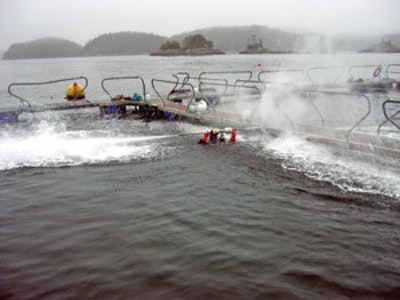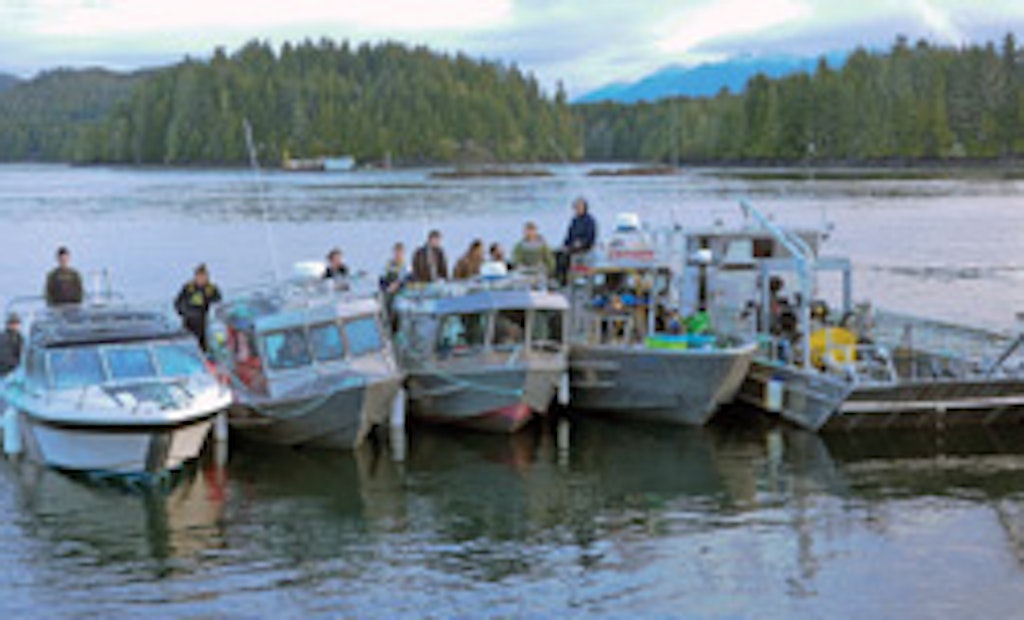Interested in Cleaning?
Get Cleaning articles, news and videos right in your inbox! Sign up now.
Cleaning + Get AlertsMussels growing six layers thick on the offshore salmon cage nets of an aquaculture farm on Vancouver Island, B.C., were reducing the flow of water enough to threaten the fish with suffocation.
The owner contacted Cory Beaudry of Camcor Dive Services in Tofino, B.C., a commercial dive company that works specifically in the aquaculture industry, hydroblasting mollusks growing on cage nets and surrounding predator nets.
Teams of four divers motored an hour in Beaudry’s custom-built 33- by 10-foot-beam aluminum dive boat to reach the offshore farm. The twin 150 hp engines handled the 20-foot swells kicked up by gale force winds of 50 to 60 mph.
“It was ugly, but not bad enough for us to stay ashore,” says Beaudry. “Once we dove, we were under the chop where it was safe to work.” The divers removed the mussels, allowing oxygenated water to reach the salmon.
Abundant life
Anchored in 300 feet of water, the 100-foot-square by 80-foot-deep salmon pens resembled an ice cube tray with two rows of 14 compartments. Mussels multiplied on the top 30 feet of the nets – the maximum depth of sunlight penetration. Also affected was a predator net with 4-inch mesh that surrounded the pens and kept out sea lions and seals.
“Cleaning predator nets is challenging,” says Beaudry. “Divers must always be alert or a sea lion will tap on their shoulder. The animals are usually just curious, but they can tear a man apart.” His 24 full-time divers are certified by the Divers Certification Board of Canada.
The divers wore bulky 10-pound dry suits and gloves with air inside, and 30-pound lead belts. “We also wear woolly long underwear because the water is always cold,” says Beaudry. They breathed nitrox (36 percent oxygen and 64 percent nitrogen).
Divers cleaned the outside of the predator nets first. When the two men were in position, they tugged on the lifelines extending from their dive harnesses to the boat. The action communicated to the surface crew to start the X Series 27 gpm/7,500 psi diesel waterblaster from Jetstream of Houston. The 125 hp engine pushed twice the necessary gpm because the divers used zero-thrust wands.
The wands have a self-rotating tip with two center jets angled at 14 degrees. To prevent the divers from tiring too quickly fighting the backward thrust, water also jets out a diffuser at the rear.
“Cleaning underwater requires incredible buoyancy and skills,” says Beaudry. “The divers float up and down, forward and backward, constantly kicking to stay in place, while hanging onto this big wand with large pneumatic hose going to the surface. Many divers apply for the job, but few have what it takes. That’s why I pay a bonus.”
Chips and dip
Dives were limited to one hour, as the physical exertion and listening to the roar of the air through the wand exhausted the men. Even at 30 feet, the pressure was too great for earplugs, but a full facemask protected them from pulverized flying mussel shell pieces, sharp enough to puncture their suits.
Once the predator nets were cleaned, the divers lowered themselves into the salmon pens and blasted from the inside, sending clumps or big flakes of mussels to the bottoms of cages. To remove the debris, they used the farm’s air lift, an 8-inch excavation tube with 1/2-inch air hose connected to a high-volume air compressor.
By operating a valve at the bottom of the tube, the divers controlled the volume of air, creating a venturi that vacuumed up debris. A long horizontal pipe discharged the slurry to a drain box on the boat.
The men worked nonstop, rotating divers with each arrival of fresh scuba tanks until the nets were cleaned. Camcor’s prompt response to the emergency helped expand its net cleaning service to a year-round operation.







